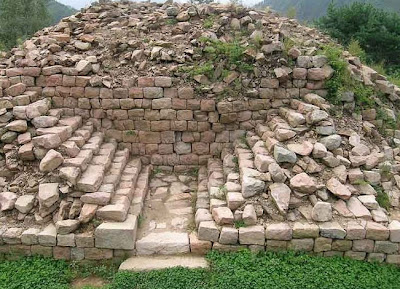Capital Cities and Tombs of the Ancient Koguryo Kingdom is a World Heritage Site (identification number 1135) located in the People's Republic of China. The designated area of the site is located in and around Ji'an, Jilin. The site was designated as a cultural World Heritage Site in 2004, qualifying as such under the first five of the six criteria for cultural heritage sites.
The site contains the archaeological remains of three cities (Wunü Mountain City, Guonei City, and Wandu Mountain City), and forty identified tombs of Koguryo imperial and noble families.
Capital Cities
Wunü Mountain City was the first capital of Koguryo Kingdom, which is the Ancient Korean Dynasty. Guonei City (Chinese: 國內城) and Wandu Mountain City (Chinese: 丸都山城) were also capitals of the Koguryo Kingdom. These areas belongs to Chinese teritory now, but back then, western chinese territory belonged to Koguryo Kingdom, which is one of the Ancient Korean Dynasty.
Wunü Mountain City is only partly excavated. Guonei City, within the modern city of Ji’an, played the role of a supporting capital after the main Koguryo capital moved to Pyongyang. Wandu Mountain City contains many vestiges including a large palace and many tombs.
The Capital Cities of the Koguryo Kingdom are an early example of mountain cities, later imitated by neighbouring cultures. The system of capital cities represented by Guonei City and Wandu Mountain City also influenced the construction of later capitals built by the Koguryo regime.
The capital cities of the Koguryo Kingdom represent a perfect blending of human creation and nature whether with the rocks or with forests and rivers.
Tombs
The site includes archaeological remains of 40 tombs which were built by Koguryo (37 BCE – 668 CE) that was founded in northern China and later extended into the northern half of the Korean Peninsula.
Some of the tombs have elaborate ceilings, designed to roof wide spaces without columns and carry the heavy load of a stone or earth tumulus (mound) which was placed above them. The tombs, particularly the important steel and a long inscription on one of the tombs, shows greatness of early Korean culture on Koguryo. The paintings in the tombs, while showing artistic skills and specific style, are also an example of strong influence from various cultures.
The tombs represent a masterpiece of the human creative genius in their wall paintings and structures. Since these are the tombs of the Kings of Koguryo, Ancient Korean Dynasty, these tombs are recognized as the Heritage of Korea.
















